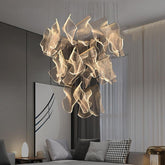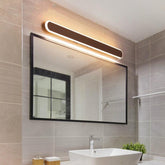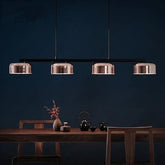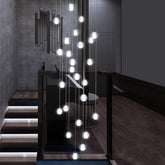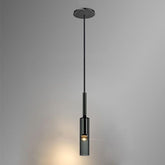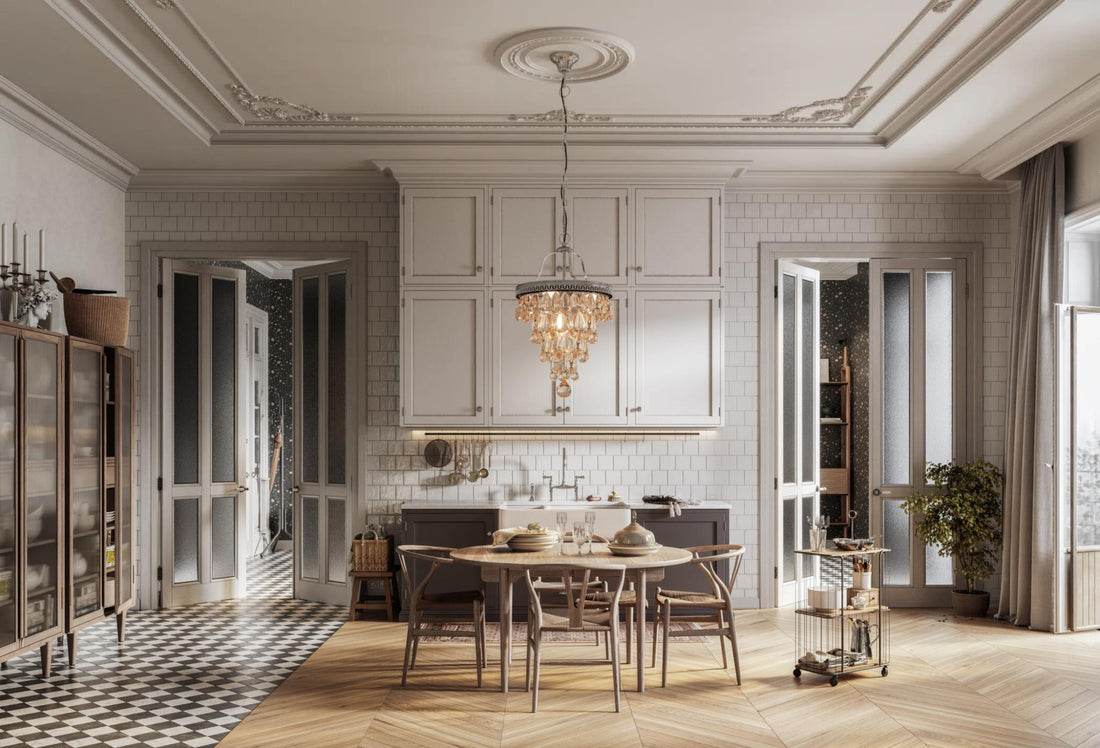Mixing and Matching: Coordinating a Modern Dining Room Chandelier with Other Lighting Fixtures
In today's design landscape, the concept of mixing and matching lighting fixtures has gained considerable traction, offering homeowners a versatile approach to creating dynamic and visually engaging spaces. In this article, we delve into the art of coordinating a modern dining room chandelier with other lighting elements to craft a harmonious and stylish ambiance.
From sleek and minimalist designs to elaborate statement pieces, modern dining room chandeliers come in a myriad of styles, shapes, and materials, each contributing to the overall aesthetic of the space in its own unique way. However, achieving a cohesive lighting scheme requires more than just selecting a stunning chandelier—it entails careful consideration of factors such as scale, proportion, style, and functionality.
Join us as we explore the nuances of mixing and matching lighting fixtures in the modern dining room, uncovering expert tips, inspiring examples, and actionable insights to help you illuminate your space with sophistication and flair.
Understanding the Role of a Modern Dining Room Chandelier
The dining room chandelier serves as more than just a source of illumination; it's a symbol of elegance, refinement, and hospitality. In today's design landscape, modern chandeliers offer a plethora of options, ranging from sleek and minimalist designs to avant-garde creations that push the boundaries of conventional aesthetics.
Definition and Purpose
Traditionally, chandeliers were ornate fixtures adorned with crystals or intricate metalwork, often found in grandiose dining halls and ballrooms. While these classic designs continue to evoke a sense of opulence and luxury, modern chandeliers have evolved to embrace contemporary sensibilities, featuring clean lines, geometric shapes, and innovative materials.
The primary purpose of a dining room chandelier remains unchanged—to provide ample illumination for dining and social gatherings while adding a touch of sophistication to the space. However, modern chandeliers also serve as statement pieces, infusing the room with personality and style.
Examples of Modern Chandelier Designs
Modern chandeliers come in a wide array of styles, ensuring that there's something to suit every taste and aesthetic preference. For those drawn to minimalist design, sleek metal chandeliers with clean lines and understated elegance may be the perfect choice. On the other hand, those with a penchant for drama and extravagance might opt for sculptural chandeliers that command attention with their bold shapes and unconventional forms.
Materials play a crucial role in defining the aesthetic of a modern chandelier. From shimmering glass and sparkling crystals to matte metals and natural wood, the possibilities are endless. Additionally, technological advancements have led to the integration of innovative features such as adjustable brightness, color-changing LEDs, and remote-controlled dimming, allowing homeowners to customize their lighting experience to suit any occasion.
Importance of Selecting the Right Chandelier
In the context of the dining room, selecting the right chandelier is paramount to creating a cohesive and inviting atmosphere. The chandelier serves as the centerpiece of the space, anchoring the design and influencing the overall ambiance.
When choosing a chandelier for your dining room, consider factors such as the size and scale of the room, the height of the ceiling, and the style of the existing decor. A chandelier that is too small may appear insignificant in a spacious dining area, while one that is too large can overwhelm the room and detract from other design elements.
Factors to Consider When Coordinating Lighting Fixtures
While the dining room chandelier undoubtedly takes center stage, achieving a cohesive lighting scheme requires thoughtful coordination with other fixtures in the room. From wall sconces and pendant lights to recessed lighting and floor lamps, each element plays a vital role in shaping the overall ambiance and functionality of the space. Here are some key factors to consider when mixing and matching lighting fixtures in your modern dining room:
Overall Design Aesthetic and Theme
Before selecting lighting fixtures, it's essential to establish the overall design aesthetic and theme of your dining room. Are you aiming for a contemporary, minimalist look, or do you prefer a more traditional, classic style? Consider factors such as color palette, furniture selection, and architectural features to ensure that your lighting choices complement the existing decor seamlessly.
For instance, in a modern dining room with clean lines and neutral tones, sleek and streamlined lighting fixtures such as linear pendant lights or geometric wall sconces can enhance the minimalist aesthetic without overwhelming the space. On the other hand, in a more eclectic or bohemian-inspired dining room, mixing and matching fixtures with varying textures, shapes, and finishes can add visual interest and personality.
Scale and Proportion
Maintaining the right scale and proportion is crucial when coordinating lighting fixtures in the dining room. A chandelier that is too large or too small for the space can disrupt the visual balance and harmony, detracting from the overall design scheme.
To ensure proper scale and proportion, consider the size of your dining table and the height of your ceiling when selecting a chandelier. As a general rule of thumb, the diameter of the chandelier should be roughly half to two-thirds the width of the dining table. Additionally, ensure that the chandelier is hung at the appropriate height—typically 30 to 36 inches above the tabletop for optimal illumination and visual impact.
When incorporating other lighting fixtures such as wall sconces or pendant lights, aim for consistency in scale and proportion to create a cohesive and balanced look. For example, if you have a large chandelier above your dining table, opt for smaller, complementary fixtures along the walls or in adjacent areas to maintain visual harmony.
Consistency in Finishes, Materials, and Colors
Another important consideration when mixing and matching lighting fixtures is consistency in finishes, materials, and colors. While it's certainly possible to incorporate a mix of different styles and designs, ensuring coherence in the overall aesthetic can help tie the room together and create a unified look.
Choose lighting fixtures that complement one another in terms of finishes and materials—for example, pairing a matte black chandelier with matching wall sconces or pendant lights can create a cohesive and modern aesthetic. Similarly, incorporating accents of the same color or material throughout the room, such as brushed brass hardware or glass accents, can enhance visual continuity and coherence.
Functionality and Practicality
In addition to aesthetics, it's essential to consider the functionality and practicality of your lighting layout. The dining room serves multiple purposes beyond just dining, from hosting social gatherings and entertaining guests to working or studying in a well-lit environment.
When planning your lighting scheme, think about the various activities that take place in the dining room and how different lighting fixtures can support these functions. For example, adjustable pendant lights or wall sconces with dimmer switches allow you to customize the lighting level based on the occasion, whether it's an intimate dinner party or a lively family gathering.
Furthermore, consider the placement of lighting fixtures to ensure adequate illumination across the entire space. Avoid placing fixtures too close together or too far apart, as this can create uneven lighting and shadows. Instead, aim for a well-balanced distribution of light that enhances visibility and creates a welcoming atmosphere for all who enter the room.
Tips for Mixing and Matching Lighting Fixtures
Now that we've explored the key factors to consider when coordinating lighting fixtures in your modern dining room, let's delve into some expert tips for mixing and matching different types of fixtures to create a cohesive and visually appealing lighting scheme:
Layering Different Types of Lighting
One of the most effective strategies for creating depth and ambiance in your dining room is to layer different types of lighting. Instead of relying solely on a single chandelier or overhead fixture, consider incorporating a combination of ambient, task, and accent lighting to illuminate the space from various angles and create a multi-dimensional effect.
Start by establishing a base layer of ambient lighting with your chandelier or overhead fixture, providing overall illumination that sets the mood for the room. Then, layer in task lighting, such as pendant lights or adjustable wall sconces, to provide focused illumination for specific activities such as dining, reading, or working.
Finally, add accent lighting, such as recessed lights or LED strips, to highlight architectural features, artwork, or decorative elements within the room. By layering different types of lighting, you can create a dynamic and versatile lighting scheme that enhances both the aesthetic appeal and functionality of your dining space.
Choosing Complementary Styles and Shapes
When mixing and matching lighting fixtures, it's essential to consider how different styles and shapes can complement one another to create a cohesive look. While variety can add visual interest, too much contrast or discordance can disrupt the overall harmony of the room.
To achieve a balanced and cohesive lighting scheme, look for fixtures that share similar design elements or motifs, such as geometric shapes, clean lines, or organic forms. For example, if you have a contemporary chandelier with angular metal frames, consider pairing it with pendant lights featuring similar geometric shapes or wall sconces with sleek, minimalist designs.
Similarly, pay attention to the scale and proportion of each fixture relative to the others to ensure visual harmony. While it's okay to mix different styles and shapes, aim for a sense of cohesion and continuity that ties the room together and creates a unified aesthetic.
Balancing Focal Points and Subtle Accents
In any well-designed dining room, there should be a balance between focal points that command attention and subtle accents that add layers of interest and depth. When mixing and matching lighting fixtures, consider how each fixture contributes to the overall composition and focal points within the room.
For example, your chandelier serves as the primary focal point, anchoring the design and drawing the eye towards the center of the room. To complement this focal point, incorporate subtle accents such as wall sconces, under-cabinet lighting, or table lamps to add layers of illumination and visual interest throughout the space.
Experiment with different heights and placements for your lighting fixtures to create a sense of movement and flow within the room. For instance, staggered pendant lights above the dining table or asymmetrical wall sconces along the walls can add a dynamic and contemporary touch to the space.
Expert Tip: Play with Scale and Proportion
Don't be afraid to play with scale and proportion when mixing and matching lighting fixtures in your dining room. Contrasting sizes and heights can create visual intrigue and drama, adding a sense of depth and dimension to the space.
For instance, consider pairing a large, statement chandelier with smaller, understated wall sconces or pendant lights to create a striking juxtaposition of scale. Alternatively, mix fixtures of varying heights and shapes to create a dynamic and visually engaging lighting composition that draws the eye upwards and around the room.
Experiment with different combinations until you find a balance that feels right for your space, taking into account factors such as the size and layout of the room, the height of the ceiling, and the overall design aesthetic. By embracing creativity and exploring unconventional pairings, you can create a truly unique and personalized lighting scheme that reflects your individual style and enhances the beauty of your dining room.
Final Words
By understanding the role of a modern dining room chandelier as both a functional necessity and a striking design element, we've laid the foundation for a lighting scheme that not only illuminates but also elevates the dining experience. From sleek and minimalist designs to bold and dramatic statements, the options are endless when it comes to selecting the perfect chandelier for your space.
Furthermore, by considering factors such as scale, proportion, consistency in finishes, and functionality, we've unlocked the potential for a harmonious and cohesive lighting layout that enhances the overall aesthetic and ambiance of the room. Whether you prefer a contemporary, minimalist look or a more eclectic and bohemian vibe, the key lies in finding the right balance of elements that speak to your individual style and sensibilities.


